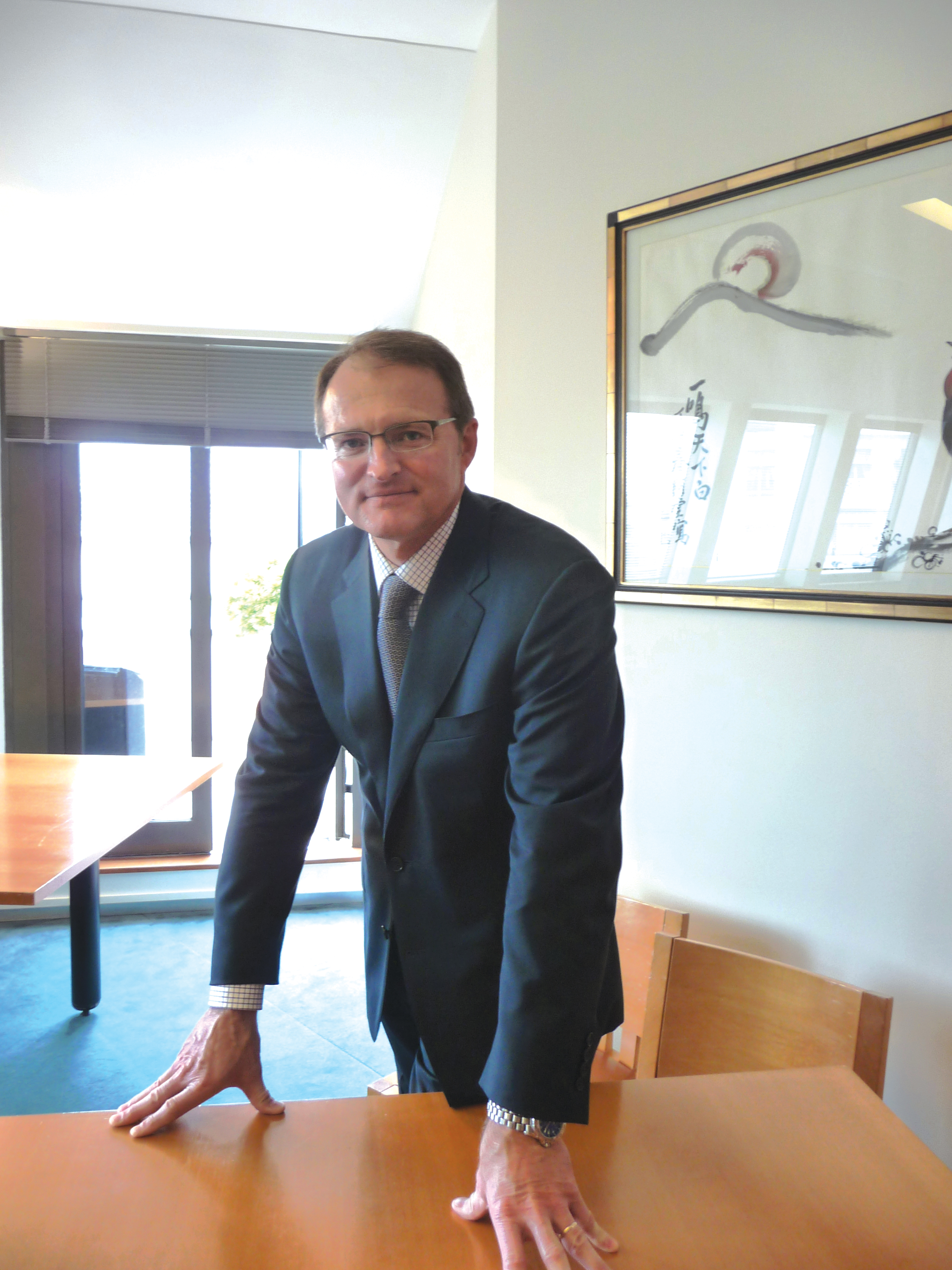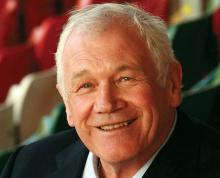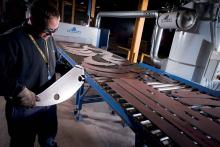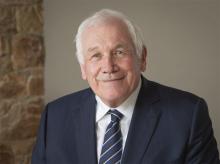
Ken MacLean has a senior job with building materials group Lafarge but he still likes the outdoors - and racing cars. Julie-Anne Ryan reports
There’s nothing more “outdoors” than a quarry, so Ken MacLean’s current position as senior vice president of aggregate performance at
MacLean has been with the company for 25 years. He grew up, though, in the family business, an industrial supply company that bought and sold equipment for various industries including mining and construction.
Successful though that business may have been, it’s still quite a professional journey from Nova Scotia, one of the Maritime provinces of Canada, to a senior management position with one of the world’s top providers of building materials, and a major producer of cement, aggregates and concrete. In 2011, Lafarge posted sales of €15.3 billion.
Growing up so close to a wild, natural environment seems to have left its mark on MacLean both in terms of his enthusiasm for ecology, which is reflected in the way he approaches a big part of his job and in his enduring love of the outdoors.
“I’ve always loved being outdoors,” he says. “I worked with the family business and I loved the outside construction element of it. I don’t have much time these days, but I still love working outdoors. I have a property now where I can do that.”
He also admits to being “very sporty”, with a penchant for racing cars, ice hockey and target shooting.
But a senior vice president’s office in the company headquarters in Rue des Belles Feuilles, Paris, means a sharp suit and a keen eye for corporate advancement.
“I went to the University of New Brunswick to study for an engineering and business degree,” he says. “After that, I started with a company owned by Lafarge in Ontario.”
His new job was in a construction engineering capacity, and he was soon working in the industry in the aggregates sector involved in building plants and facilities. “Eventually I got promotion into management, and then I was promoted again into managing ready mix businesses, aggregates: I got lots of experience in that area. As time went on I picked up more responsibility, took on a more functional role.”
Promotions continued over the next decade or so, and he found himself in business unit management. In 2008 the decision was made to merge the Eastern Canada and East US aggregates and concrete business, with MacLean becoming president of the new regional unit based in Alpharetta, Georgia.
When his latest promotion took effect he moved to Paris with his wife and their five sons more than a year ago, and is steeped in the issues facing the worldwide aggregates industry, generally and specifically.
So far, he says, “It’s been interesting and challenging. Lafarge provides an environment for that: there are always many different opportunities to take on new challenges. That’s why I’ve developed over the years, with acquisitions and so on.”
In his current job in Paris, MacLean casts his management net wide: “I oversee the entire product line, minerals management, looking at supply management, the concept of continual improvement – extracting the best value we can from every aspect of the business.
“Our aggregates business operating model is called ROCK. That’s the thread that holds our business together, drives the business around the world. Implementing that, it’s a series of best practices, something our employees can look up to and understand. It’s an innovative model applied everywhere we operate with the highest marketing and manufacturing standards to master our operations. This approach really reflects the strapline we have adopted for performance: ‘winning everywhere, today and tomorrow’.”
He adds: “It’s not just processes, not just a market, it’s people too. And land, and resources: we need to optimise everything.”
MacLean is already seeing the benefit of Lafarge’s move to a more country-based organisation. “Restructuring is going well. I have travelled quite a bit and I have a good frame of reference on that. It’s the whole concept of ‘One Lafarge’ - sharing expertise, understanding our customers - which is the key part of the whole thing of maximising our resources. We are seeing a lot of little successes when it all comes together under one umbrella in one country. Most people are excited about it: it is exciting, what it’s opened up for us.”
One of the key issues currently facing the industry as a whole is biodiversity, sustainability: namely, the move to ensure that the relentless use of resources by quarrying companies is mitigated as much as possible by corporate initiatives to preserve, reuse, simply to care.
Sustainability Ambitions 2020 is a statement by Lafarge that it has entered a new phase in its sustainability commitment. It is the continuation of the company’s 2007-12 programme, at the end of which it had achieved and surpassed its key commitment of reducing net CO2 emissions per tonne of cement produced by 20%.
Lafarge chairman and CEO Bruno Lafont said recently that “a green economy cannot happen without a green industry, and there is no sustainability without a responsible industry, aware of its social contribution and steering its own change.”
The Lafarge programme is a 34-point sustainability plan, which creates value for all of its stakeholders: shareholders, customers, employees and communities local to its production plants. Its targets include reducing by 33% CO2 emissions per tonne of cement compared to 1990 levels; using 50% of non-fossil fuels in Lafarge cement plants by 2020 (including 30% biomass); reaching zero fatalities and virtually eliminating lost-time incidents for employees and contractors; having 35% of senior management positions held by women, and contributing one million volunteer hours per year to locally selected projects.
Research and development is key to Lafarge’s growth, and sustainable construction and architectural creativity define the company. The “unique” research and development centre in Lyon, France, houses 250 nationally diverse researchers offering expertise in the most recent fields of the chemistry of hydration, organic chemistry, physics, rheology, and micromechanics. There are also partnerships with the Ecole des Ponts Paris Tech with a Science of Materials for Sustainable Construction chair, and a budget of almost €130 million dedicated to innovation, with 60% going to sustainable construction.
MacLean becomes particularly animated when he talks about biodiversity.
“It all starts with quarries,” he says. “Aggregates are non-renewable resources and have to be treated with the utmost respect. In some communities it’s hard to get resources. We want to consider it the Lafarge way: looking at the community and how we rehabilitate, make sure that we follow best practice in quarrying, ensuring that no resources are wasted.
“Over the past 25 years I’ve seen instances where approval to win reserves has been very challenging, making it very difficult to supply customers to the region. In these instances it’s important to work closely with the relevant authorities to look at application to see if it can be altered to address certain issues, including using a blend of reserves.
“In all contexts, rehabilitation work is key. When we enact our plans we want to make sure management works to those standards. We have to understand protection and preservation and we have training and management plans to upgrade people’s knowledge of that. Some people are, of course, naturally inclined to look at these issues as part of their job. It’s a huge part of our business: we have to preserve our environment.”
Always keen to champion the retention of corporate knowledge, something that’s reflected in his enthusiasm for the training and education programmes throughout Lafarge, he’s not one to discard the wide-ranging experience and knowledge he’s picked up over his career. And he knows that the current emphasis on sustainability isn’t new.
“I have seen examples of people who have done remarkable things. Even 25 years ago they were doing this, people were saying: ‘you shouldn’t waste that, it might be valuable in the future even if it isn’t today.’ That’s what I would like to drive in our business.”
MacLean’s commitment to rehabilitation is reflected in Lafarge’s performance. By the end of 2011, 86% of quarries had a rehabilitation plan in place and 97% of quarries had carried out biodiversity screening, using criteria established with worldwide conservation organisation, WWF.
In its new Ambitions statement, Lafarge targets 100% of its quarries with a rehabilitation and biodiversity management plan by 2015.
The industry must always be looking at ways to maximise resources, to research constantly and to create where it can’t substitute, believes MacClean.
Manufacturing sand is one example of the innovation that he’s seen over the years. Lafarge uses recycled glass for sand in some areas: in the UK, it uses 10 million bottles every year. Again he refers to a presentation he heard “many years ago” by the UK Cast Stone Association, which explained the scarcity of resources and the importance of recycling.
MacLean looks closely at every aspect of this issue and is clearly an active part of the company’s drive.
“How can we maximise things? We have done some research with respect to using aggregates. We work a lot with cement. Aggregate is a building product by itself. How does it work? Look at sand resources and the possibilities there: recycled concrete is also used in the market.”
Lafarge has been undertaking extensive R&D into aggregates since 2003 to better understand aggregates and their characteristics – physical and chemical compositions. This work has borne fruit in recent years, as Lafarge is able to use its system of classification to make rapid and accurate assessments of new deposits, particularly in emerging countries.
“I am excited about the aggregates business,” he says, almost unnecessarily. “These are tough times in Europe but I think aggregates in general have tremendous opportunities down the road. We haven’t even tapped into it! Aggregates are used everywhere and the more we can promote aggregates’ usefulness the more use it’s going to have. It’s a product that’s relatively affordable and access is easy in these countries, and we’re seeing changes in the way we’re using it, in asphalt and in manufacturing to name just two.”
Constant changes, research and development will lead to further growth, he says.
“There could be some technological breakthrough in the next ten years or so that leads us to break it differently, or grade it differently: a lot of these countries are looking at opportunities to use aggregates differently.”
Lafarge, he says, is always optimising, always looking for opportunity in emerging markets where it might be possible to grow business.
“We’re always looking to tweak it.”
The energy MacLean brings to his role is fed daily by Lafarge’s position among those at the top of the sector.
“I line up against all kinds of player. For me, it’s pushing our model, pushing resources. We can always improve, we can continually focus ourselves, and that’s what I intend to do. Over the next five years or so I would like to see us differentiate ourselves from others, to improve our performance as an organisation in every way, not just commercially. How we make an offer to the customer, how we understand the customer better, the products and services we give. To do that at a high level we have to make sure that our processes and supply chain are done at a high level.
“It’s a challenge because of the diversity around the world, with respect to our approach, because things that work in the US might not work in other countries. But with our operational model, we have the means to do that. We have our training: a lot of training material. We need to make sure that people utilise the tools in their tool box. For me, doing that is challenging, I enjoy it.”
The family man has no intention of trying to direct his childrens’ paths, preferring to let them make their own way.
“We have moved around a lot: eight times or more. We’ve lived in the US for more than ten years, and now we’re here in Paris. They’ve lived in different communities, and it all means that they can see the world a bit differently, it opens their minds. When I went to school it was to get a job, but these days if you can get something you enjoy that’s much better.
“We are living in a complex world today. Three to four years back I don’t think we knew we were going to be in the predicament we find ourselves in now. The world is getting smaller all the time, our children see things differently. Even their thought processes are different.
“Sustainable growth is what we’re after. Sustainable mineral growth, but also sustainable in how we operate. We continually want to improve it. For me, it’s been a challenge. I like a challenge.”










